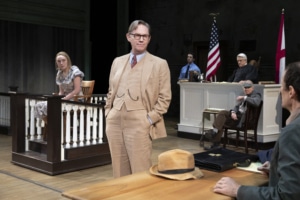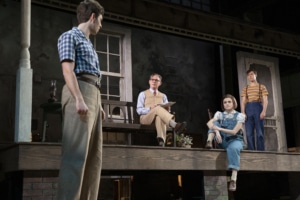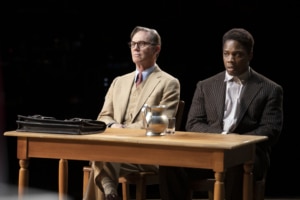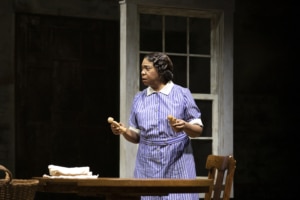DCPA NEWS CENTER
Enjoy the best stories and perspectives from the theatre world today.
Enjoy the best stories and perspectives from the theatre world today.
The Broadway adaptation’s writer Aaron Sorkin talks about updating and paying homage to Harper Lee’s American classic today.
Excerpted from Simms, David. “A New Way of Looking at To Kill a Mockingbird.” The Atlantic, December 17, 2019

(L to R) Arianna Gayle Stucki (Mayella Ewell), Richard Thomas (Atticus Finch), Stephen Elrod (Bailiff), Richard Poe (Judge Taylor), Greg Wood (Mr. Roscoe), and Joey Collins (Bob Ewell) in To Kill a Mockingbird. Photo by Julieta Cervantes
The first line of Aaron Sorkin’s stage adaptation of To Kill a Mockingbird is one of quiet confusion. “Something didn’t make sense,” Scout Finch tells the audience of the tale that’s about to unfold. Sorkin’s dramatization of Harper Lee’s novel, which opened on Broadway in December 2018, is an unexpectedly probing work that refuses to let an American classic go unchallenged. Instead, it stages two trials: One is from the book, in which Scout’s attorney father, Atticus Finch, defends Tom Robinson, an African American man accused of rape in 1930s Alabama, and tries to combat the community’s entrenched racism.
In Sorkin’s play, the other trial is of Atticus’s own nobility, and how it doesn’t always square with his grander vision of justice. Though the adaptation broadly follows the narrative arc of Lee’s novel, it uses Scout, her brother Jem, and her friend Dill (all played by adult actors) to cast a wary eye over some of the book’s more idealistic details. That framing encourages the audience to ponder the limits of Atticus’s impulse to empathize even with vile racists such as Bob Ewell, a man who’s trying to pin his own assault of his daughter Mayella on Tom. The play beefs up the relatively anonymous parts given to black characters in Lee’s work, gives Atticus’s kids a more argumentative nature, and sheds harsher light on the book’s somewhat pat ending.
The stage adaptation is nonetheless made with appreciation for Lee’s novel, and that mix of homage and update has translated into a family-friendly Broadway hit.

(L to R) Justin Mark (Jem Finch), Richard Thomas (Atticus Finch), Melanie Moore (Scout Finch), and Steven Lee Johnson (Dill Harris) in To Kill a Mockingbird. Photo by Julieta Cervantes
David Sims: The show surprised me. I knew the book, and I had seen the film multiple times, so I was not expecting to be surprised.
Aaron Sorkin: I’m glad to hear that. From the moment the curtain goes up, we try to knock you off your pins a little bit. Scout spends the play trying to solve [the mystery of Bob Ewell’s death], but broadly what we’re doing is having a new conversation about the book, the story we all learned in seventh grade and thought we knew.
When I started out [with this play], I thought it was a suicide mission, but I said yes right away ’cause I wanted to do a play so badly. My first draft was terrible because I tried to gently swaddle the book in bubble wrap and transfer it to the stage. It felt like a greatest-hits album done by a cover band—just somebody trying to imitate Harper Lee and standing up the most famous scenes from the book. I realized that Atticus, as the protagonist [of the stage version of the] story, has to change. And if he’s gonna be the protagonist, he has to have a flaw.

Richard Thomas (Atticus Finch) and Yaegel T. Welch (Tom Robinson) in To Kill a Mockingbird. Photo by Julieta Cervantes
How did Harper Lee get away with having a protagonist who doesn’t change? Because Atticus isn’t the protagonist in the book or the movie; Scout is—her flaw is that she’s young, and the change is that she loses some of her innocence. While I wanted to explore Scout, I absolutely wanted Atticus to be a traditional protagonist, so he needed to change and have a flaw … It turned out that Harper Lee had [already] given him one; it’s just that when we all learned the book, it was taught as a virtue. It’s that Atticus believes that goodness can be found in everyone.
Sims: He excuses things [such as bigotry and cruelty].
Sorkin: By the end of the play, he realizes he doesn’t know his friends and neighbors as well as he thought he did, that it may not be true that goodness can be found in everyone.
Sims: You give a lot of anger to the kids. In the novel, I don’t remember them ever challenging their father; they’re more like observers who are invested in childish obsessions, like [their mysterious neighbor] Boo Radley. But you’ve given them, especially Jem, a more defiant dynamic with Atticus.
Sorkin: Well, if Atticus is going to have all the answers, let’s ask him tougher questions.
Sims: Calpurnia [the Finch family’s black housekeeper] has more to do as well, and she’s a much more passive figure in the book.

Jacqueline Williams (Calpurnia) in To Kill a Mockingbird. Photo by Julieta Cervantes
Sorkin: I returned to the book and was surprised to find that in a story about racial tension, there were really only two significant African American characters, neither of whom had much to say. I want to be careful—this play is in no way meant to correct what I feel were mistakes that Harper Lee made. It’s a conversation. And I couldn’t do a Harper Lee impersonation or pretend like I was writing the play in 1960. But Calpurnia in the book is mostly concerned with whether Scout’s going to wear overalls or a dress; Tom Robinson pleads for his life, but we don’t know much more about him. In 1960, using African American characters mostly as atmosphere is something that probably would have gone unnoticed by a mostly white audience. But it would be noticeable today, and it’s a really big missed opportunity. You want their point of view in this.
Sims: It’s been an interesting year for great American works getting interrogated on Broadway.
Sorkin: They’re not getting repainted. We’re just taking another look, given the times we’re living in.
DETAILS
To Kill a Mockingbird
Jan 24-Feb 5 • Buell Theatre
Tickets
